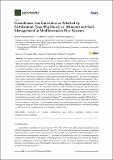Por favor, use este identificador para citar o enlazar a este item:
http://hdl.handle.net/10261/214281COMPARTIR / EXPORTAR:
 SHARE SHARE
 CORE
BASE CORE
BASE
|
|
| Visualizar otros formatos: MARC | Dublin Core | RDF | ORE | MODS | METS | DIDL | DATACITE | |

| Campo DC | Valor | Lengua/Idioma |
|---|---|---|
| dc.contributor.author | Moreno-García, Beatriz | es_ES |
| dc.contributor.author | Guillén, Mónica | es_ES |
| dc.contributor.author | Quílez Sáez de Viteri, Dolores | es_ES |
| dc.date.accessioned | 2020-06-14T10:10:36Z | - |
| dc.date.available | 2020-06-14T10:10:36Z | - |
| dc.date.issued | 2020-04 | - |
| dc.identifier.citation | Agronomy 10(4): 493 (2020) | es_ES |
| dc.identifier.uri | http://hdl.handle.net/10261/214281 | - |
| dc.description | 19 Pags.- 4 Figs.- 5 Tabls.- Suppl. Mats. (1 Fig.- 2 Tabls.). © 2020 by the authors. Licensee MDPI, Basel, Switzerland. This article is an open access article distributed under the terms and conditions of the Creative Commons Attribution (CC BY) license | es_ES |
| dc.description.abstract | The great increase in livestock production in some European areas makes it necessary to recycle organic slurries and manures and to integrate them in crop production. In Northeast Spain, the application of pig slurry (PS) is being extended to alternative crops such as rice due to the great increase in pig production. However, there is a lack of information of the effect of substitution of synthetic fertilizers with pig slurry on greenhouse gas (GHG) emissions in rice crop, and this information is key for the sustainability of these agricultural systems. The aim of this study was to evaluate the effect of the substitution of mineral fertilizers by PS on GHG emissions in Mediterranean flooded rice cultivation conditions under optimal nitrogen (N) fertilization. Two field experiments were carried out in two different (contrasting) soil types with different land management. Site 1 had been cultivated for rice in the previous three years with no puddling practices. Site 2 had been cultivated for rice for more than 15 years with puddling tillage practices and had higher organic matter content than site 1. The cumulative nitrous oxide emissions during the crop season were negative at both sites, corroborating that under flooded conditions, methane is the main contributor to global warming potential rather than nitrous oxide. The substitution of mineral fertilizer with PS before seeding at the same N rate did not increase emissions in both sites. However, at site 1 (soil with lower organic matter content), the higher PS rate applied before seeding (170 kg N ha−1) increased methane emissions compared to the treatments with lower PS rate and mineral fertilizer before seeding (120 kg N ha−1) and complemented with topdressing mineral N. Thus, a sustainable strategy for inclusion of PS in rice fertilization is the application of moderate PS rates before seeding (≈120 kg N ha−1) complemented with mineral N topdressing. | es_ES |
| dc.description.sponsorship | This study was funded by the National Institute for Agricultural and Food Scientific Research and Technology of Spain (INIA), the Government of Aragón, FEDER, and FEADER funds (RTA2010-0126-C02-01, RTA2013-0057-C05-04 and DRU-2014-02-50-541-00-IFO-00740020007). B. Moreno-García was granted with an FPI-INIA fellowship. | es_ES |
| dc.language.iso | eng | es_ES |
| dc.publisher | Multidisciplinary Digital Publishing Institute | es_ES |
| dc.relation.isversionof | Publisher's version | es_ES |
| dc.rights | openAccess | es_ES |
| dc.subject | Flooded rice | es_ES |
| dc.subject | organic fertilization | es_ES |
| dc.subject | pig slurry | es_ES |
| dc.subject | Methane | es_ES |
| dc.subject | nitrous oxide | es_ES |
| dc.subject | Mediterranean conditions | es_ES |
| dc.title | Greenhouse gas emissions as affected by fertilization type (pig slurry vs. mineral) and soil management in mediterranean rice systems | es_ES |
| dc.type | artículo | es_ES |
| dc.identifier.doi | 10.3390/agronomy10040493 | - |
| dc.description.peerreviewed | Peer reviewed | es_ES |
| dc.relation.publisherversion | https://doi.org/10.3390/agronomy10040493 | es_ES |
| dc.identifier.e-issn | 2073-4395 | - |
| dc.rights.license | https://creativecommons.org/licenses/by/4.0/ | es_ES |
| dc.contributor.funder | CSIC - Instituto Nacional de Investigación y Tecnología Agraria y Alimentaria (INIA) | es_ES |
| dc.contributor.funder | Gobierno de Aragón | es_ES |
| dc.contributor.funder | European Commission | es_ES |
| dc.relation.csic | Sí | es_ES |
| oprm.item.hasRevision | no ko 0 false | * |
| dc.identifier.funder | http://dx.doi.org/10.13039/501100010067 | es_ES |
| dc.identifier.funder | http://dx.doi.org/10.13039/501100000780 | es_ES |
| dc.identifier.funder | http://dx.doi.org/10.13039/100007652 | es_ES |
| dc.contributor.orcid | Quílez Sáez de Viteri, Dolores [0000-0002-2638-9443] | es_ES |
| dc.type.coar | http://purl.org/coar/resource_type/c_6501 | es_ES |
| item.fulltext | With Fulltext | - |
| item.languageiso639-1 | en | - |
| item.openairecristype | http://purl.org/coar/resource_type/c_18cf | - |
| item.openairetype | artículo | - |
| item.cerifentitytype | Publications | - |
| item.grantfulltext | open | - |
| Aparece en las colecciones: | (EEAD) Artículos | |
Ficheros en este ítem:
| Fichero | Descripción | Tamaño | Formato | |
|---|---|---|---|---|
| QuilezD_Agronomy-Basel_2020.pdf | 13,62 MB | Adobe PDF |  Visualizar/Abrir |
CORE Recommender
SCOPUSTM
Citations
4
checked on 20-abr-2024
WEB OF SCIENCETM
Citations
1
checked on 25-feb-2024
Page view(s)
176
checked on 21-abr-2024
Download(s)
127
checked on 21-abr-2024
Google ScholarTM
Check
Altmetric
Altmetric
Este item está licenciado bajo una Licencia Creative Commons

